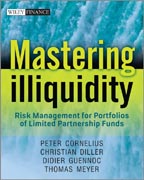
Mastering Illiquidity
Meyer, Thomas
Cornelius, Peter
Diller, Christian
Guennoc, Didier
Arms investors with powerful new tools for measuring and managing the risks associated with the various illiquid asset classes With risk–free interest rates and risk premiums at record lows, many investors are turning to illiquid assets, such as real estate, private equity, infrastructure and timber, in search of superior returns and greater portfolio diversity. But as many analysts, investors and wealth managers are discovering, such investments bring with them a unique set of risks that cannot be measured by standard asset allocation models. Written by a dream team of globally renowned experts in the field, this book provides a clear, accessible overview of illiquid fund investments, focusing on what the main risks of these asset classes are and how to measure those risks in today?s regulatory environment. Provides solutions for institutional investors in need of guidance in today?s regulatory environment Offers detailed descriptions of risk measurement in illiquid asset classes, illustrated with real life case studies Helps you to develop reliable risk management tools while complying with the regulations designed to contain the individual and systemic risks arising from illiquid investments Features real–life case studies that capture an array of risk management scenarios you are likely to encounter INDICE: Foreword xi Acknowledgements xiv 1 Introduction 1 1.1 Alternative investing and the need to upgrade risk management systems 1 1.2 Scope of the book 4 1.3 Organization of the book 6 PART I ILLIQUID INVESTMENTS AS AN ASSET CLASS 2 Illiquid Assets, Market Size and the Investor Base 17 2.1 Defining illiquid assets 17 2.2 Market size 20 2.3 The investor base 23 2.4 Conclusions 32 3 Prudent Investing and Alternative Assets 33 3.1 Historical background 34 3.2 Prudent investor rule 36 3.3 The OECD guidelines on pension fund asset management 38 3.4 Prudence and uncertainty 38 3.5 Conclusion 41 4 Investing in Illiquid Assets through Limited Partnership Funds 43 4.1 Limited partnership funds 43 4.2 Limited partnerships as structures to address uncertainty and ensure control 47 4.3 The limited partnership fund’s illiquidity 49 4.4 Criticisms of the limited partnership structure 52 4.5 Competing approaches to investing in private equity and real assets 52 4.6 A time–proven structure 55 4.7 Conclusion 57 5 Returns, Risk Premiums and Risk Factor Allocation 59 5.1 Returns and risk in private equity 59 5.2 Conclusions 73 6 The Secondary Market 75 6.1 The structure of the secondary market 76 6.2 Market size 83 6.3 Price formation and returns 87 6.4 Conclusions 93 PART II RISK MEASUREMENT AND MODELLING 7 Illiquid Assets and Risk 97 7.1 Risk, uncertainty and their relationship with returns 98 7.2 Risk management, due diligence and monitoring 102 7.3 Conclusions 105 8 Limited Partnership Fund Exposure to Financial Risks 107 8.1 Exposure and risk components 108 8.2 Funding test 113 8.3 Cross–border transactions and foreign exchange risk 117 8.4 Conclusions 121 9 Value–at–Risk 123 9.1 Definition 123 9.2 Value–at–risk based on NAV time series 124 9.3 Cash flow volatility–based value–at–risk 129 9.4 Diversification 136 9.5 Factoring in opportunity costs 141 9.6 Cash–flow–at–risk 143 9.7 Conclusions 144 10 The Impact of Undrawn Commitments 149 10.1 Do overcommitments represent leverage? 150 10.2 How should undrawn commitments be valued? 151 10.3 A possible way forward 153 10.4 Conclusions 159 11 Cash Flow Modelling 161 11.1 Projections and forecasts 162 11.2 What is a model? 163 11.3 Non–probabilistic models 167 11.4 Probabilistic models 171 11.5 Scenarios 178 11.6 Blending of projections generated by various models 179 11.7 Stress testing 180 11.8 Back–testing 184 11.9 Conclusions 187 12 DistributionWaterfall 189 12.1 Importance as incentive 190 12.2 Fund hurdles 191 12.3 Basic waterfall structure 193 12.4 Examples for carried interest calculation 195 12.5 Conclusions 202 13 Modelling Qualitative Data 207 13.1 Quantitative vs. qualitative approaches 207 13.2 Fund rating/grading 208 13.3 Approaches to fund ratings 211 13.4 Use of rating/grading as input for models 216 13.5 Assessing the degree of similarity with comparable funds 218 13.6 Conclusions 220 14 Translating Fund Grades into Quantification 221 14.1 Expected performance grades 221 14.2 Linking grades with quantifications 225 14.3 Operational status grades 228 14.4 Conclusions 229 PART III RISK MANAGEMENT AND ITS GOVERNANCE 15 Securitization 233 15.1 Definition of securitization 233 15.2 Financial structure 237 15.3 Risk modelling and rating of senior notes 239 15.4 Transformation of non–tradable risk factors into tradable financial securities 244 15.5 Conclusions 248 16 Role of the Risk Manager 249 16.1 Setting the risk management agenda 249 16.2 Risk management as part of a firm’s corporate governance 251 16.3 Built–in tensions 253 16.4 Conclusions 255 17 Risk Management Policy 257 17.1 Rules or principles? 258 17.2 Risk management policy context 258 17.3 Developing a risk management policy 262 17.4 Conclusions 264 References 267 Abbreviations 277 Index 279
- ISBN: 978-1-119-95242-8
- Editorial: John Wiley & Sons
- Encuadernacion: Cartoné
- Páginas: 304
- Fecha Publicación: 10/05/2013
- Nº Volúmenes: 1
- Idioma: Inglés
